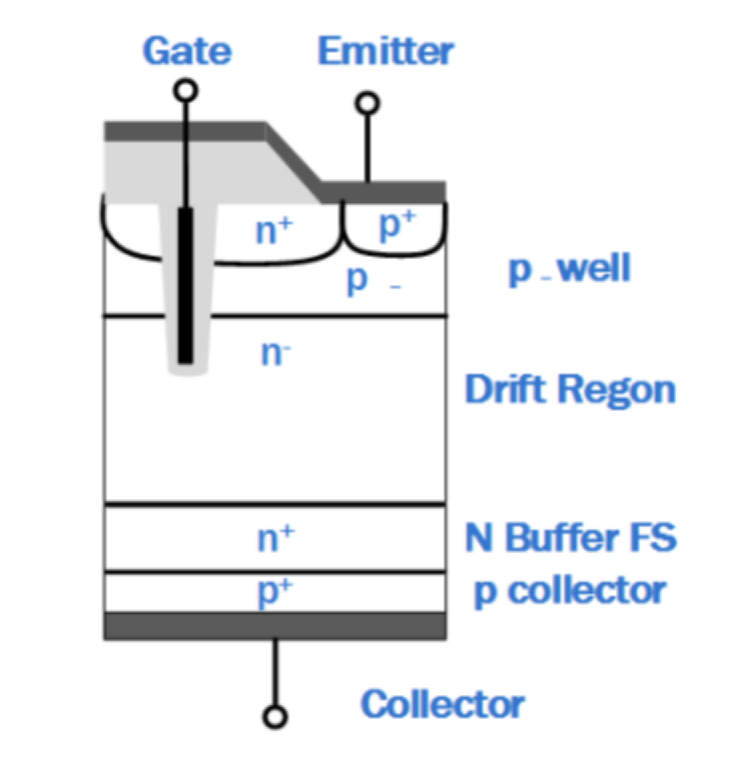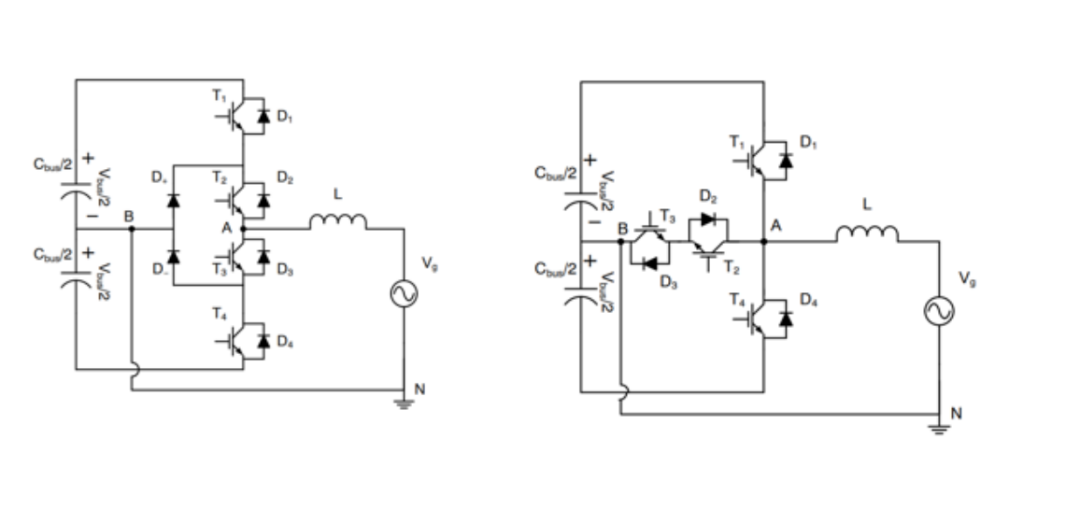While some may view IGBT as a "legacy" technology, it still plays an important role in high-power applications.
Today, much of the news coverage and discussion in the semiconductor industry is about devices based on new wide-band gap (WBG) materials such as silicon carbide (SiC) and gallium nitride (GaN). But just a few years ago, the solution of choice for many applications was the insulated-gate bipolar transistor (IGBT).
Medium to high power applications using IGBTs still exist, as do the devices themselves. In this article, we will look at IGBTs in detail and then consider existing and emerging applications for which they are suitable.
IGBT: Physical structure
An IGBT is a semiconductor transistor or semiconductor switch consisting of four alternating layers of semiconductor material (PNPN). When the right voltage is applied to the gate of the device, it is able to conduct current - when that voltage is removed, the conduction stops.
Since its introduction, IGBTs have been continuously honed and improved, especially in terms of improving switching losses as well as creating thinner structures. Today, IGBTs typically combine a channelled gate with a field cutoff structure as a means of suppressing parasitic NPN characteristics within the device. Once this is achieved, conduction losses and saturation voltage are reduced, resulting in benefits such as enhanced power density.

Figure 1: Field channel cut-off IGBT structure
Examples of IGBT usage and techniques
Igbts are used in a wide range of applications, including solar inverters, energy storage systems, uninterruptible power supplies (UPS), motor drives, electric vehicle chargers, industrial welding, and home appliances. Often, topologies are chosen specifically to meet the needs of a particular application, so we'll compare and contrast some popular applications.
Industrial welding
Given the need for higher quality welding, the welding process needs to be controlled more precisely. Therefore, an inverter is usually used instead of a typical welding transformer because the DC output current can achieve the necessary accuracy.
There is also a safety aspect to this, as direct current is generally considered safer. From the user's point of view, the inverter is smaller and lighter than the transformer, so the welding machine is more portable and easier to use.
In a typical welder, a single - or three-phase AC power supply is rectified to form a DC bus voltage. The rectifier also powers a small converter to generate the voltage required by the control unit. The DC bus voltage powers the inverter, which typically has a nominal output voltage of about 30 VDC. However, during use, under open-load operation, the voltage can double and drop to almost 0V when the welding arc is triggered (effectively a short circuit).

Figure 2: Overview of a typical welder
Many different topologies are available for inverter-based welders. However, the most common include full bridge (FB), half bridge (HB), and double switch forward. In FB and HB topologies, the switching frequency is tens of kHz, usually in the range of 20-50 kHz. Duty cycle is controlled according to load level and output voltage. As far as control schemes are concerned, this is usually a constant current.

Figure 3: Common topologies include FB, HB, and double-switch forward.
Industrial motor driver
One of the most common industrial applications is industrial motor drivers, which can be used in robots, large machinery, or many other applications that require movement. Most motor drive applications are configured for HB, with frequencies between 2 kHz and 15 kHz. The resulting output voltage depends on the switching state and current polarity.

Figure 4: Half-bridge topology showing positive and negative output currents.
The motor is inductive load, so the current increases quickly. When a positive current is flowing (Ig >0), the high-side transistor (T 1) will be switched on, delivering energy to the load (V g). However, if the load current I g flows in the other direction (negative polarity), the current flows back through D 1, returning the energy to the DC source.
If the low-side transistor is on (T4 on) and the high-side transistor (T 1) is off, a voltage equal to minus half of the V bus (-V bus /2) will be applied to the load, reducing the current. If IGg is greater than zero, the current flows through D4 returning the energy to the bus source.
Modern induction cooker
Induction cooker cooking replaces the traditional electric heating element that generates heat and transfers it to the pan/pot, using the principle of excitation coils to force or couple the current to circulate within the bottom of the pan. In order for an induction cooker to work properly, the bottom of the pan must be physically close to the coil, and only certain metals are suitable - materials with high magnetic permeability are needed.
The principle is similar to a common power transformer, with the coil as the primary and the pot bottom as the secondary. It also has a lot in common with modern inductive charging technology.
The heat needed to heat the pot comes from the eddy circulation in the bottom layer of the pot, or more specifically, the resistance to the flow of these currents. Using inductive coupling, about 90% of the energy is transferred to produce heat in the pot. A typical smooth-top non-inductive furnace can only transmit about 70% of the energy, so losses are reduced by three times.
The topology used is not very different from the welding circuit. A small auxiliary power supply that drives the inverter and controller after the main AC is rectified. The inverter induces an electric current into the copper coil, which creates an electromagnetic field and induces eddy currents in the pan. The heat generated is equal to the resistance at the bottom of the pan multiplied by the square of the induced current - known as the "Joule effect."

Figure 5: Overview of a typical induction cooker circuit
Different from the welding machine, the control scheme of the induction furnace is usually a frequency conversion scheme. While this is a simple approach, the challenge lies in the frequency range required to control the output power over a large area.
Even at the high frequencies required by the induction furnace, the resonant converter can operate with high efficiency. Therefore, resonant loop converters are commonly used for this application, especially resonant half-bridge (RHB) converters and quasi-resonant (QR) inverters. RHB converters are particularly valued for the wide range of loads they can handle. Typically, advanced control technologies such as zero current switches (ZCS) or zero voltage switches (ZVS) are used to ensure that power losses are kept to a minimum.

Figure 6: Typical RHB and QR topology examples
Due to the cost effectiveness of this topology, QR converters are often used in low power (less than 2 W peak power) induction furnace applications.
Solar inverters and UPS
There are many challenges when using half-bridge topologies in applications that require fast switching, including:
There can only be two output voltages
Switching losses can be high
Driving the gates can be challenging
Component stress affects reliability
The increased ripple current and EMI require a lot of filtering
Incompatible with HVDC bus
Thermal design is no small matter
In modern applications, HB topologies are being replaced by key applications such as uninterruptible power supplies (UPS) and solar photovoltaic (PV) inverters. Three-level topologies are becoming dominant - known as Type I and Type T.
There are many areas that need to be improved, including reducing the voltage at both ends of the active component, which reduces losses, reduces harmonic distortion and allows for the use of smaller components. Most importantly, these topologies significantly reduce switching losses, with up to 98% efficiency when switching at high frequencies from 16 kHz to 40 kHz.

Figure 7: The Type I and T converter topologies have many advantages over HB.
Look to the future
While some may view IGBT as a "legacy" technology, it still plays an important role in high power (high voltage/current) applications. IGBT technology continues to advance, with Vcesat values approaching 1 V, and structural improvements have increased density and reduced losses.















